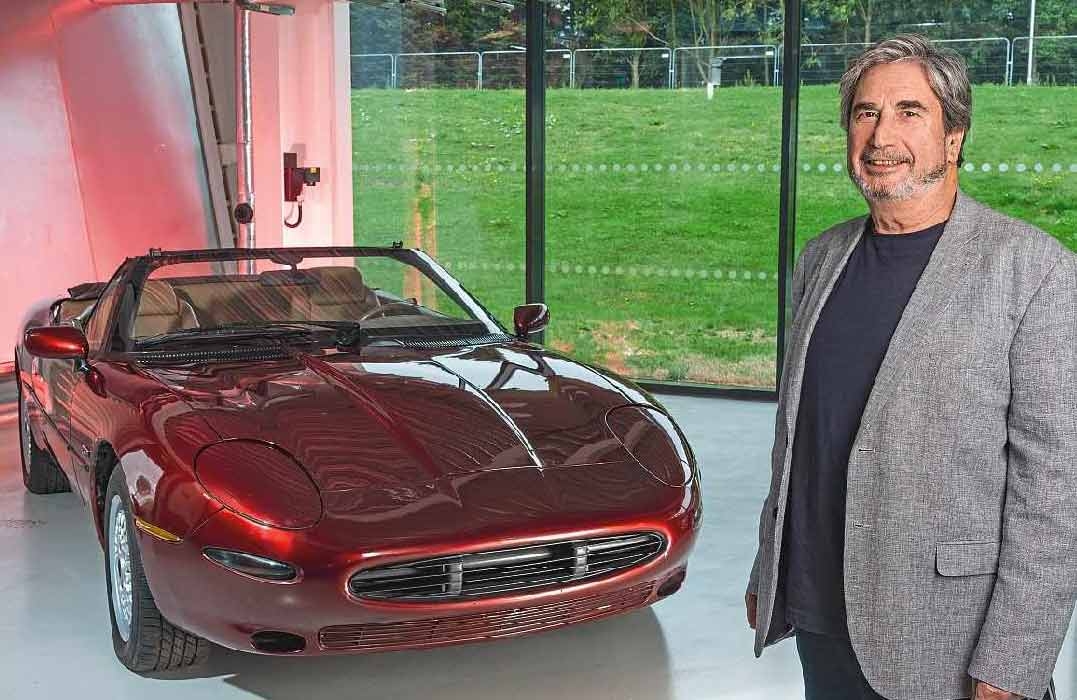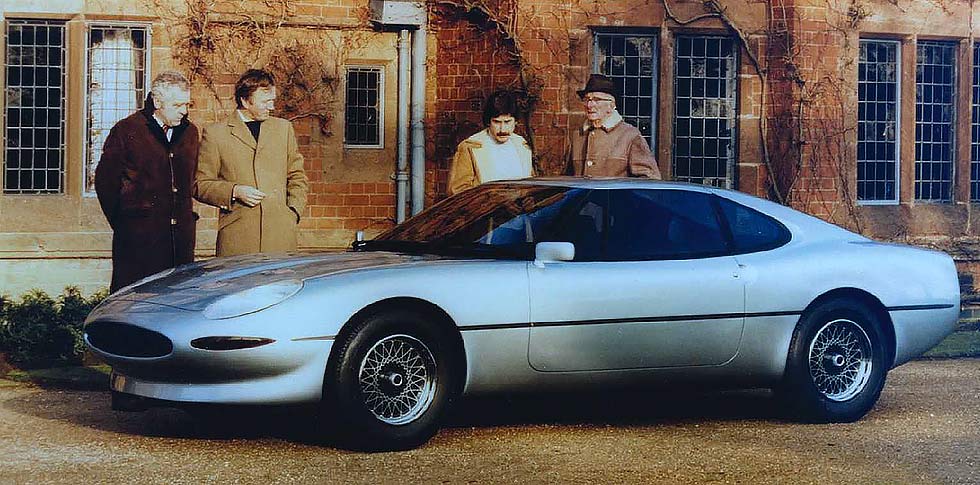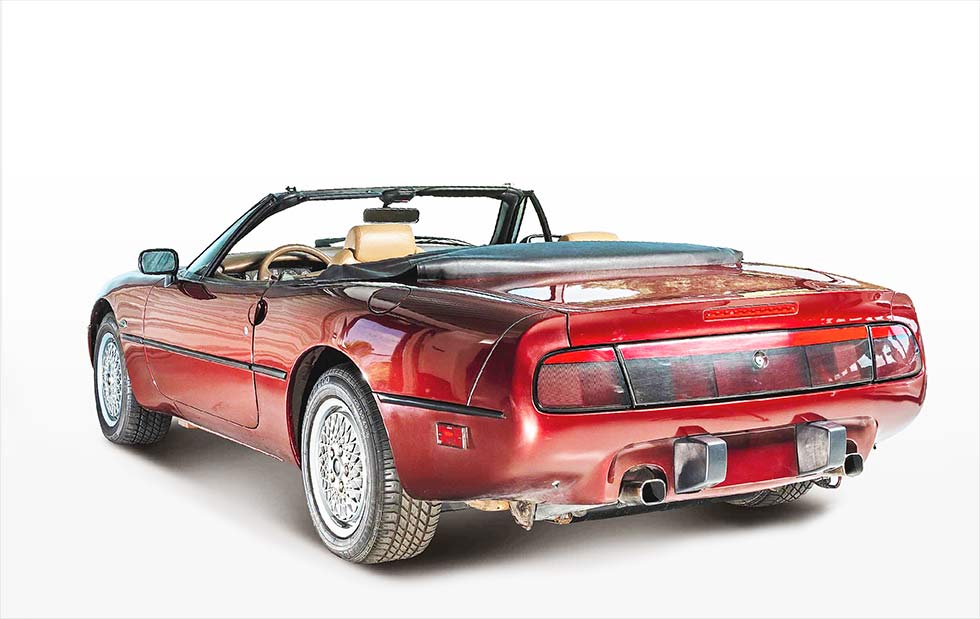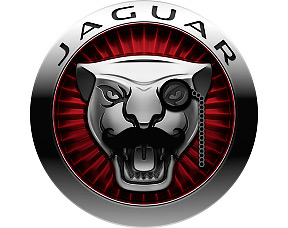
“I was distraught, I was absolutely gutted. It had all gone so sour and I was really upset about it” The XJ41 was supposed to be the XJ-S’ replacement, but despite the car’s return to Jaguar’s traditional curves, rising costs saw the project cancelled. We talk to the man who designed it, Keith Helfet, about the car’s controversial history… Words Paul Walton. Photography Antony Fraser.
HISTORY XJ41
XJ41: THE F-TYPE THAT COULD HAVE BEEN The XJ41 is the car that was supposed to replace the XJ-S in the Eighties, yet Ford cancelled it. We look at one of the remaining prototypes and talk to the man who designed it, Keith Helfet.
The back of Jaguar Heritage’s facility at the British Motor Museum in Gaydon, there is a pretty, red, four-seat convertible. It wears Jaguar badges and has many of the company’s familiar styling cues, yet it’s clearly not a production model. Consequently, visitors often ignore it in favour of more famous cars.

What they don’t realise it that this red car is one of the few remaining prototypes of the XJ41 project, in which Jaguar invested millions during the Eighties, and what was tipped to be the XJ-S’ replacement. Although this development car has obviously had a hard life, it’s still very pretty, with gorgeous soft lines and perfect proportions – and, if anyone were to look under the bonnet, they’d find a turbocharged version of the AJ6 engine. The car hasn’t turned a wheel under its own power for some time, but in its day it was very fast and could easily have put Jaguar into the supercar league long before the XJ220.
“The engineers sometimes wanted an easy life, but this was my baby; I owned it”
Sadly, rising costs, an overly complicated specification and internal politics sealed the XJ41’s fate and today it remains just a footnote in the company’s history. But should it? I believe the car is more significant than that, being an important link between Jaguar’s past and future. Plus, it was an illustration of what the company was capable of creating three decades ago.

The project was born (as many of Jaguar’s good ideas were) in engineering director Jim Randle’s head. In early 1980, Randle was trying to persuade the BL board to back the XJ40. He knew that the business argument to invest the millions Jaguar needed would be strengthened if more than just the saloon were to come off that platform. Plus, at the time, the XJ-S was less than loved and needed to be replaced at some point anyway. Therefore, spinning off a sports car in the normal Jaguar way (by reducing a saloon’s wheelbase from 113in to 102in) seemed liked common sense.
Jim asked Jaguar’s chassis engineer, Tom Jones, to look into how to get 50/50 weight distribution from the shortened XJ40 platform. Between them, they came up with the novel idea of turning the wishbones back to front, thereby moving the wheels further forward.
In early 1980, everyone in the design team was asked to sketch a sports car suitable for the chassis, including Keith Helfet, the South African designer who had joined the company in April 1978. Although the trend at the time was for slab-sided, origami design themes with flat panels – cars such as the Lotus Esprit and Volkswagen Golf – Keith knew from the outset what he wanted. “For me, the origami styling fashion from the mid-Seventies to the early Eighties was completely unappealing. I don’t do square lines; I do flowing sculpture and that’s what Jaguars are about.”
Keith was always influenced by Sir William Lyons’ and Malcolm Sayer’s work, and his sketches show a handsome car that unashamedly features the similar soft curves of the D- and E-type. He also designed more than one car. “I liked the idea of a targa; I wanted it, the coupe and the convertible to have the same proportions since one can often look like an after thought.”

Once the design team of around just six had submitted their individual designs, the next step was to choose one that would be shown to the BL board. But, it wouldn’t be chosen by Randle, or even Keith’s immediate boss, studio director Doug Thorpe. It was down to someone with considerably more experience in designing Jaguars. Explains Keith, “Jim – because he’s clever – decided there was only one natural person who should choose: Sir Williams Lyons.”
Although Lyons had retired in 1972, Jaguar’s founder and president was still a regular visitor to the studio, offering advice that the young designers gladly followed. “He used to come in once about fortnight, more if something was bugging him. But things moved slowly then, so there wasn’t much for him to look at.”
Internally codenamed XJ41 for the coupe and XJ42 for the convertible (that many would later informally call the F-type) the submissions for the sports car were put on display. Lyons apparently went straight to Keith’s sketches, pointed his stick and said simply, “Do that one.”
For Keith, this was a huge turning point in his career. He’d spent his first two years at Jaguar in the shadows, designing bits and pieces for the XJ40’s interior, and then, suddenly, the company’s founder chose his sports car. “I was shocked,” he admits. “I had simply designed something I liked; I never thought about the end process.”
In mid-1980, Jim Randle presented the business case for the XJ40 and XJ41 to the BL board in the ballroom of London’s Grosvenor Hotel. Keith was there to talk through his sketches. “It was my first taste of corporate glamour,” he says. Approval was given in February 1981, as was the required £80 million that kicked off the project.
Keith soon had a modeller assigned to him, who began by creating quarter-scale models. Since Sir William never sketched, preferring instead to design his cars in metal, it wasn’t really until there was a 3D model of the XJ41 that he really latched onto it, coming into the studio every week. “With the XJ41 model, he’d say to me, ‘Keith I’ve been thinking about…’ In other words, in the preceding week it had clearly been on his mind.
“Doug Thorpe kept out of the way during these visits and while Jim was always present, he would only listen. He never offered any opinion. This meant that Sir William was effectively my boss. Yet he wasn’t adding ideas – I was still the car’s proposer. He was simply helping me to make judgments on what was and wasn’t working.”
The fact that Sir William had a full-scale model of the XJ41 displayed outside his home at Wappenbury Hall is a clear indication of his close involvement with the project. Lyons had always preferred to critique new designs in natural light, finding the privacy of his Edwardian estate the ideal place to look at them, where the tall trees that surround the house cast shadows across the car.
At this point, the project was still moving swiftly towards its original 1986 launch date, having been added to Jaguar’s official product plan in 1982. It was to use Jaguar’s all-new AJ6 engine, which was later turbocharged, resulting in 330bhp. That was an impressive figure for the mid-Eighties, when a Porsche 911 Turbo had just under 300bhp. The engine had been 15 degrees to the vertical on the XJ40, but when the turbochargers were added there wasn’t space under the 41’s bonnet, so it was righted.
In 1984, Jaguar’s New Vehicle Concepts (NVC) took over the project and it was very keen to use computer-aided design (CAD). As Jaguar’s first car to be designed this way, the company didn’t have the expertise, and that delayed the project. “The master model was eventually done in Paris by a company called Hartman since it was the only place in Europe that had a five axis [a milling machine that can cut from five points rather than the traditional three] big enough to CNC a whole car, which could then be digitised.” Every single component of the XJ41 had to be laboriously converted from drawings into 3D, which took up further time and even more money. The cars would be made by computer-aided manufacturing, the first Jaguar to be built this way.
Although NVC didn’t change the overall design (which had been finalised in 1984/85), they didn’t think some of Keith’s design ideas would work, such as lamp covers that dropped to reveal the lenses. “When I was creating a car in Cape Town from plaster of Paris in the early Seventies, I wanted a modern-looking car with a smooth bonnet, but hated the idea of pop-up lamps – aerodynamically, they weren’t very good and the things don’t pop up at the same time. I thought it would make more sense to have them in a sugar scoop and let the covers drop down. When I was working on the XJ41 I thought, ‘Let’s do the same thing,’ but the engineers said it couldn’t work.” In the end, Keith had to work out a mechanism that would drop the light covers; when the lights come on they drop, revealing the light. The reason the engineers had said it wouldn’t work was because the bottom of the light scoop wasn’t flat – so Keith invented a way that would make it work.
Keith also remembers fighting to keep the smooth line at the rear and to have a steel beam under a plastic cover as per his original design, which was more complicated than an old-fashioned bumper. Freely admitting that he was, perhaps, too passionate about the car, Keith says, “The engineers sometimes wanted an easy life, but this was my baby; I owned it. I was like a dog with a bone and would often come into conflict with people. But I felt like I was safeguarding the design and I didn’t want it to become just another car.” One of the first major changes was the addition of all-wheel drive. “There was a belief that so much power needed 4×4, plus it was very fashionable at the time thanks to the success of the Audi Quattro. But this put up the car’s weight and the cost of development.”
In the late Eighties, the German contract manufacturer Karmann was asked to build several prototypes, including the red convertible seen here, plus a white coupe and a dark-grey targa-roofed car. In Paris, Hartman also made several glass-fibre examples for clinics (where manufacturers ask potential customers behind closed doors for their thoughts on the new models, and immediate rivals’ cars).
They were a nod towards the eventual production car, featuring various wheel options, plus some of the later design updates made by Keith and the engineering team. In total, Jaguar invested £50 million in developing specialised tooling for the car.
The XJ41 was cliniced three times during its development – all carried out in North America, Jaguar’s most important market. The first was in the early Eighties and although it went well there were, says Keith, still some negative views. The second, a couple of years later, was better, and the third, in late 1988, was just before the XJ220 concept’s debut, so Keith wasn’t able to attend but which was still very successful. According to Keith, the car was compared against the Ferrari 328 and Porsche 911, among others, and it came out on top by a big margin. “They voted it the best-looking car there and those are the opinions that mattered.”
However, all was not well behind the scenes. There were concerns that the car was too heavy and that it wasn’t performing as planned (although Keith says the prototype still hit 190mph at the Nardo test track in Italy) and its development costs had risen dramatically. These issues, coupled with the fact that Jaguar’s new owner, Ford, wasn’t interested in the car because it had been started before it took control, resulted in the programme being cancelled in 1989.
Yet Keith never gave up on the XJ41, and worked out another, cheaper way. “A fewmonths later, I went to see Jim and said that it could be done on an XJ-S platform. With the same wheelbase and same track width, plus the A-posts in the same place, you could put the body on the XJ-S platform. He took my proposal to Jaguar Sport [a separate company owned 50/50 by Jaguar and TWR to build sportier models] and, at the board meeting, Tom Walkinshaw said, ‘We could build that.’”
Now called Project XX and under Walkinshaw’s control, it was still a Jaguar product and Keith remembers writing a brief on behalf of the studio director at the time, Geoff Lawson, explaining what could and couldn’t change to the design. But, unbeknown to Keith, Jim and everyone else at Jaguar, Walkinshaw had already approached Ford with an idea that the car be badged as an Aston Martin, also owned by the American giant, because it could then ask for a higher purchase price. Ford’s bosses agreed. So, in 1994, the DB7 was born. When I ask Keith if he was upset that his creation was no longer a Jaguar, and it being taken away from him, he thinks for a minute before replying, “I am pleased that it lived on; it would have been such a waste otherwise.”
The remaining XJ41 prototypes languished in various workshops before being handed over to the Jaguar Heritage Trust, but sadly the clinic cars were destroyed in the early 2000s, leaving just the red convertible and grey targa development hacks as proof the project ever existed. It’s not known what happened to the white coupe, but it, too, was probably destroyed. Due to a continuing feeling by many that Jaguar should have built the car, they were rarely displayed, although they did appear on the front cover of the July 1998 issue of JaguarWorld, when Paul Skilleter compared them to a then-new XKR. When I took over the reins as editor in 2012, I regularly saw both cars in Jaguar Heritage’s former warehouse in Coventry, covered in dust and looking forlorn, their place in Jaguar’s history uncertain.
Thankfully, times have changed. With Jaguar now having a two-seater sports car there is less anxiety felt towards the XJ41, so the red convertible is currently proudly displayed at Jaguar Heritage’s new Collections Centre.
Despite it being a development mule, I’ve always been taken aback by how well it was made. The steel exterior panels fit perfectly, while inside is a fully finished interior. Yes, there are some parts sourced from the XJ-S, but many of the touch points are unique to the car and everything fits together perfectly; with little or no gaps, it is a testament to the £50million Jaguar invested into the project and of using computer-aided manufacturing. The interior is very modern but, dare I say, ordinary compared to the contemporary XJ-S’, lacking the angular lines and unusual barrel instruments that still give the older car a big personality.
Tellingly, like a recovered watch from the Titanic with hands forever pointing to 1.45am, under the XJ41’s bonnet there’s a handwritten sticker for the air filter, dated August 1989, the time the project ended. Although the electrics still work allowing us to lower the windows and raise the lamp covers, when I ask the always-helpful Heritage volunteers when was the last time the car started, they just shrug. A long time ago. As a prototype of a car that never reached production and therefore has little PR value, I doubt it ever will.
When Keith arrives at Jaguar Heritage and sees his creation once again, he is visibly pleased. It has been 25 years since he last saw the car, yet he still knows every curve, line and nuance, in the same way a parent knows their child’s face. The world might have forgotten about the XJ41, but he hasn’t.
Despite its problems, the XJ41’s importance to Jaguar’s history shouldn’t be overlooked: it was the final Jaguar with input from Sir William Lyons, linking the car directly to the XJ6, XK 120, 140 and 150 etc, all the way back to his little Austin Seven Swallow of 1927. Also, after years of the XJ-S’ hard lines, the XJ41 recaptured Jaguar’s voluptuous curves – something that Jaguar would return to again with the X100 generation of XK8. And, finally, as a pointer towards the future, the XJ41 was the first Jaguar to feature a blown engine and all-wheel drive, both popular options with the current range.
Fast, good-looking and with an impeccable heritage, it remains the best car Jaguar never built.
Thanks to: Jaguar Daimler Heritage Trust (www.jaguarheritage.com)
ABOVE: The XJ42 convertible being critiqued during a clinic held at a Beverly Hills hotel.
LEFT: The carbon fibre coupe built by Karmann and used for clinics.
RIGHT: The XJ42 convertible that was used for clinics.
BELOW: One of the original French-made models.
Three development hacks, plus the two clinic cars behind.
FAR LEFT: One of Keith’s early drawings showing the coupe, targa and convertible versions.
LEFT: Another early sketch. The inclusion of the older Jaguar sports cars shows how Keith wanted the car to be viewed.






